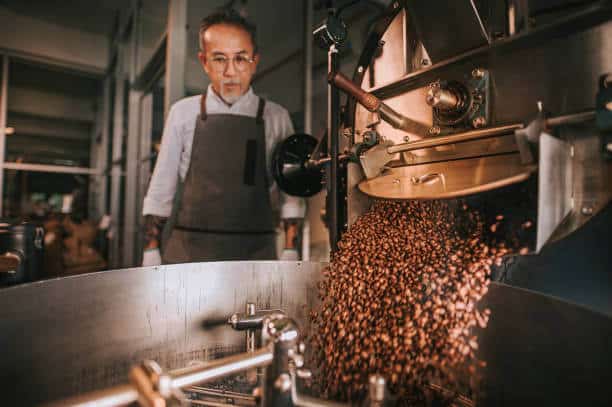Hey there! Let’s talk about coffee blends. Simply put, a coffee blend is a mixture of two or more types of coffee beans. It’s like mixing different flavors of ice cream to create a new and exciting taste. Coffee blends can be made from different regions or countries and combine beans with different roast levels.
The goal of blending coffee is to create a unique and balanced flavor profile that is impossible with a single-origin coffee. Coffee blenders experiment with different combinations of beans to achieve a specific taste and aroma. It’s like a secret formula that only the coffee blender knows.
Coffee shops and roasters use coffee blends to create a signature, stand-out flavors. So, the next time you’re sipping on your favorite coffee blend, remember that it’s a unique combination carefully crafted by a coffee expert.
Coffee blends are important because they offer a unique flavor profile that cannot be achieved with a single-origin coffee. Blending different types of coffee beans together creates a harmonious balance of flavors and aromas that complement each other.
Here are some of the reasons why coffee blends are important:
- Consistency: Blending allows roasters to maintain a consistent taste profile year-round, even as the quality and characteristics of individual coffee beans change with the seasons.
- Complexity: Blending different beans with varying flavor profiles creates a complex and unique taste greater than the sum of its parts. This can add depth and character to a cup of coffee.
- Balance: Blends can help to balance out the flavors of different beans. For example, a darker roast might be paired with a lighter roast to balance the acidity and bitterness.
- Cost: Blending can help reduce coffee production costs, as it allows roasters to mix higher-priced beans with lower-priced beans to create a more affordable blend.
- Versatility: Blends can be tailored to different brewing methods, such as espresso or drip coffee, to achieve the best possible taste.
Coffee blends are important because they offer a consistent, complex, balanced flavor profile that is versatile and cost-effective.
The history of coffee blending dates back to the early days of the coffee trade, when coffee beans were first brought to Europe from their origin in Ethiopia. Initially, coffee was consumed as a single-origin beverage. Still, as the coffee trade grew and spread worldwide, coffee roasters began experimenting with blending different beans together to create a unique taste profile.
In the 19th century, coffee blending became more widespread and popular as coffee consumption grew in Europe and North America. Roasters began to develop specific blends for different tastes and brewing methods, such as espresso blends for Italian-style coffee and milder blends for American-style drip coffee.
Today, coffee blending is a common practice in the coffee industry and is used by roasters worldwide to create various unique and complex flavor profiles. Coffee blends can be made up of beans from different regions and include Arabica and Robusta varieties, depending on the desired taste and caffeine content.
Types of Coffee Blends

There are basically 3 main types of blends which we will briefly explain now.
Single-Origin Blends
Single-origin blends are a type of coffee blend that is made up of coffee beans from a single country or region. Unlike traditional blends, which combine beans from multiple origins to create a unique taste profile, single-origin blends aim to showcase the distinct characteristics and flavors of coffee from a particular region.
Single-origin blends have become increasingly popular in recent years as coffee enthusiasts and specialty coffee shops seek out unique and high-quality beans. By focusing on a single origin, roasters can highlight the specific flavor notes, acidity, and body of the coffee, allowing consumers to experience the unique characteristics of different regions.
Some popular single-origin blends include Ethiopian Yirgacheffe, Colombian Supremo, and Sumatran Mandheling. Each of these coffees has its own unique flavor profile and is often sought out by coffee lovers for its distinct taste.
Single-origin blends can also be used as the base for more complex blends, providing a foundation of flavor that can be built upon with other beans. Overall, single-origin blends offer a way to experience the diversity and complexity of coffee from different regions, while also highlighting the unique qualities of each origin.
Definition and Characteristics
A coffee blend is a combination of two or more different types of coffee beans that are roasted and blended together to create a unique taste profile. The characteristics of a coffee blend will depend on the types of beans used, the roasting process, and the blending ratio.
Here are some of the key characteristics of coffee blends:
- Flavor profile: Coffee blends can have a wide range of flavor profiles, from rich and chocolaty to fruity and floral. The specific flavor notes will depend on the types of beans used and how they are roasted and blended together.
- Balance: Blending different beans together can help to balance out the flavors and create a more well-rounded taste. For example, a darker roast might be blended with a lighter roast to balance out the acidity and bitterness.
- Consistency: Coffee blends can help to ensure a consistent taste profile year-round, even as the quality and characteristics of individual coffee beans change with the seasons.
- Versatility: Coffee blends can be tailored to different brewing methods, such as espresso or drip coffee, to achieve the best possible taste.
- Complexity: Blending different beans with varying flavor profiles can create a complex and unique taste that is greater than the sum of its parts.
Overall, coffee blends offer a way to create a unique and consistent taste profile by blending different types of beans together. The specific characteristics of a blend will depend on the types of beans used and the roasting and blending process.
related article in just another cuppa coffee
If you are a coffee enthusiast, you might have heard of single origin coffee beans and their unique flavors. As a coffee lover, I have always been fascinated by the different types of coffee available in the market. One of the most exciting types of coffee that I have come across is single-origin coffee.
Popular Single-Origin Blends
Here are some examples of popular single-origin blends in the world of coffee:
- Ethiopian Yirgacheffe: This coffee is known for its floral and citrusy flavor profile, with hints of blueberry and chocolate. It is often used as the base for single-origin blends and is a favorite among coffee enthusiasts.
- Colombian Supremo: This coffee is grown in the high altitudes of Colombia and is known for its rich, full-bodied flavor. It has a mild acidity and a sweet, nutty finish, making it a popular choice for both single-origin and blended coffees.
- Sumatran Mandheling: This coffee is grown on the island of Sumatra in Indonesia and has a unique, earthy flavor with hints of dark chocolate and tobacco. It is often used in blends to add depth and complexity to the flavor profile.
- Kenyan AA: This coffee is grown in the high-altitude regions of Kenya and is known for its bright acidity, fruity notes, and wine-like finish. It is a popular choice for single-origin espresso blends and is prized for its complex flavor profile.
- Costa Rican Tarrazu: This coffee is grown in the Tarrazu region of Costa Rica and is known for its bright acidity and clean, crisp flavor profile. It has hints of citrus and honey, and is often used as a base for light-bodied blends.
These are just a few examples of the many single origin blends available in the world of coffee. Each has its own unique flavor profile and characteristics, making them a favorite among coffee lovers who appreciate the diversity and complexity of different coffee origins.
Blended Blends
Blended blends are a type of coffee blend that combines two or more different coffee blends to create a unique taste profile. This is done by blending together different types of coffee beans from different regions or roasts to create a unique and complex flavor profile.
Definition & Characteristics
- Flavor profile: Blended blends can have a wide range of flavor profiles, depending on the types of blends used and the blending ratio. The flavors of the different blends can be balanced or accentuated in order to create a unique taste profile.
- Consistency: Blended blends can help to ensure a consistent taste profile year-round, even as the quality and characteristics of individual coffee blends change with the seasons. By blending together different blends, roasters can create a consistent taste profile that is unique to their brand.
- Complexity: Blended blends can be more complex than single-origin blends or traditional blends because they can include a wider variety of beans and flavors. This complexity can create a more interesting and unique drinking experience for coffee lovers.
- Versatility: Blended blends can be tailored to different brewing methods, such as espresso or drip coffee, to achieve the best possible taste.
- Creativity: Blended blends allow roasters to be creative and experimental with their coffee offerings. By combining different blends together, they can create new and unique flavor profiles that stand out from the competition.
Overall, blended blends offer a way to create a unique and consistent taste profile by blending different types of blends together. The specific characteristics of a blend will depend on the types of blends used and the roasting and blending process.

Popular Blended Blends
Blended blends can vary widely in terms of the types of beans used and the blending ratio, but here are some examples of popular blended blends in the world of coffee:
- Moka Java: This blend combines beans from Ethiopia and Indonesia to create a unique flavor profile with chocolatey and fruity notes. It is one of the oldest and most famous blended blends in the world of coffee.
- Breakfast Blend: This blend is a combination of light-roasted beans from Central and South America. It is designed to be a mild and smooth coffee with a bright acidity and a clean finish.
- French Roast Blend: This blend is made up of dark-roasted beans from South and Central America, as well as Indonesia. It has a bold and smoky flavor with a rich body and low acidity.
- Espresso Blend: This blend is specifically designed for espresso and combines beans from different origins to create a full-bodied, rich, and creamy espresso with a thick crema.
- Italian Roast Blend: This blend is made up of dark-roasted beans from South America and is designed to be a bold and full-bodied coffee with a smoky and slightly sweet flavor profile.
These are just a few examples of the many blended blends available in the world of coffee. Each has its own unique flavor profile and characteristics, making them a favorite among coffee lovers who appreciate the diversity and complexity of different coffee blends.
Regional Blends
Regional blends are a type of coffee blend that combines beans from the same geographic region to create a unique flavor profile. These blends are often designed to showcase the distinct characteristics of coffee from a particular region.
key characteristics of regional blends
- Flavor profile: Regional blends are designed to highlight the unique flavor characteristics of coffee from a particular region. For example, a regional blend from Latin America might have a bright acidity and fruity notes, while a blend from Africa might have a more floral and tea-like flavor profile.
- Consistency: Regional blends can help to ensure a consistent taste profile year-round, even as the quality and characteristics of individual coffee beans change with the seasons. By blending together beans from the same region, roasters can create a consistent taste profile that is unique to that region.
- Traceability: Regional blends often come with a high degree of traceability, as the beans can be traced back to specific farms or cooperatives in a particular region. This can be appealing to consumers who are interested in the origin and sourcing of their coffee.
- Sustainability: Regional blends can help to support sustainable coffee production practices, as many of these blends are sourced from smallholder farmers who use traditional and environmentally friendly farming methods.
- Versatility: Regional blends can be used for a variety of brewing methods, including drip coffee, pour-over, and espresso.
Overall, regional blends offer a way to experience the unique flavor characteristics of different coffee regions. The specific characteristics of a regional blend will depend on the types of beans used and the roasting and blending process.

Popular Regional Blends
Here are some examples of popular regional blends in the world of coffee and why we at Just Another Cuppa feel they are popular:
- Latin American Blend: This blend combines beans from countries such as Colombia, Brazil, and Costa Rica to create a bright, fruity, and slightly sweet taste profile. It is popular among coffee drinkers who prefer a milder and less acidic coffee.
- African Blend: This blend combines beans from countries such as Ethiopia, Kenya, and Tanzania to create a unique flavor profile with floral and citrus notes. African blends are popular among coffee enthusiasts who appreciate the complexity and distinctiveness of African coffees.
- Indonesian Blend: This blend combines beans from countries such as Sumatra and Java to create a bold, earthy, and full-bodied flavor profile. It is popular among coffee drinkers who prefer a darker, more intense coffee.
- Central American Blend: This blend combines beans from countries such as Guatemala, Honduras, and Nicaragua to create a well-balanced flavor profile with notes of chocolate and nuts. It is popular among coffee lovers who appreciate a smooth and easy-drinking coffee.
- South American Blend: This blend combines beans from countries such as Peru, Bolivia, and Ecuador to create a light and floral flavor profile with a medium acidity. It is popular among coffee drinkers who prefer a milder coffee with a unique taste.
These regional blends are popular because they offer a unique flavor profile that is representative of the coffee growing regions in which they are sourced. By combining beans from a specific region, roasters can create a taste profile that is consistent and distinct, allowing consumers to experience the unique characteristics of different coffee regions. Additionally, many of these regional blends are sourced from smallholder farmers who use traditional and environmentally friendly farming methods, making them a sustainable and socially responsible choice for coffee drinkers.
related article in just another cuppa coffee
If you’re looking for something new and exciting in your morning coffee routine, look no further than Koa Coffee. This Hawaiian-based company roasts some of the most flavourful beans around, resulting in a bold, intense cup of joe. Whether you’re a seasoned coffee lover or just getting started, Koa Coffee is definitely worth a try.
The Art of Coffee Blending
Blending coffee is a process that involves sourcing, roasting, and blending coffee beans. The first step is sourcing the beans, which typically involves selecting beans from different regions around the world to create a unique flavor profile. Once the beans have been sourced, they are roasted to bring out their unique flavor characteristics. Each type of bean will have its own optimal roasting profile, which will affect the taste and aroma of the final blend.
The beans are then blended together to create the final coffee blend. The types of beans used and the blending ratio will depend on the desired flavor profile. After the coffee has been blended, it is typically tested to ensure that it meets the desired taste profile. This may involve cupping, which is a process of tasting the coffee and evaluating its aroma, flavor, and body.
Finally, the blended coffee is packaged and prepared for sale, either as whole bean coffee or pre-ground coffee. Overall, blending coffee requires careful attention to the types of beans used, the roasting process, and the blending ratio to create a unique and consistent flavor profile that meets the preferences of coffee drinkers.
Importance of selecting the right beans
Selecting the right beans is crucial to the process of coffee blending because it is the foundation upon which the flavor and aroma of the coffee blend are built. Here are some reasons why selecting the right beans is important:
- Flavor Profile: Different beans have distinct flavor characteristics that are affected by factors such as the region they were grown in, the altitude, soil, and climate. Selecting beans with the right flavor profile can help to create a blend with a unique taste that is well balanced and flavorful.
- Consistency: Using the same high-quality beans in each batch of coffee ensures consistency in the taste and aroma of the coffee blend. This is important for creating a reliable and consistent coffee that customers can enjoy time and time again.
- Sustainability: Selecting high-quality beans that are sustainably sourced can help to support environmentally friendly coffee production practices and fair trade for farmers. This is increasingly important to coffee consumers who are interested in ethical and sustainable sourcing.
- Traceability: Knowing where the beans come from and how they were grown can provide a sense of transparency and trust between coffee roasters and consumers.
- Roasting: The quality of the beans used will impact the roasting process and the final flavor of the coffee. Selecting the right beans for a particular roast profile is important for creating the desired flavor and aroma.
Overall, selecting the right beans is essential for creating a high-quality coffee blend that is well-balanced, flavorful, and consistent. It also helps to support sustainable and ethical coffee production practices, which is important to many coffee consumers.
Roasting and mixing the beans

Roasting and mixing the beans are important steps in the process of coffee blending. Here’s an overview of each step:
Roasting
Once the beans have been sourced, they need to be roasted to bring out their unique flavor characteristics. Roasting is a critical step in the coffee blending process, as it can significantly affect the final taste and aroma of the coffee. During the roasting process, the beans are heated to a specific temperature, which causes them to change in color, aroma, and flavor. The degree of roasting can range from light to dark, and each degree of roast will bring out different flavor notes in the coffee. The roasting process must be carefully controlled to ensure that the beans are not over or under roasted, as this can negatively impact the final taste and aroma of the coffee.
Mixing
Once the beans have been roasted, they are ready to be mixed or blended. Blending different types of beans can help to create a unique and well-balanced flavor profile. During the mixing process, the roasted beans are combined in specific ratios to achieve the desired taste and aroma. This is an art that requires expertise and experience to achieve a consistent flavor profile. Coffee roasters must carefully select the types of beans used in each blend to ensure that they complement each other in terms of flavor and aroma. The blending process can also include mixing beans that have been roasted to different degrees, to achieve a specific flavor profile.
Overall, the roasting and mixing of beans are crucial steps in the coffee blending process. By carefully selecting and roasting beans, coffee roasters can bring out the unique flavor characteristics of each bean. By blending different beans, they can create a well-balanced and unique flavor profile that appeals to coffee drinkers.
Different flavor profiles
Coffee beans can have a wide range of flavor profiles, depending on factors such as the region they were grown in, the altitude, soil, and climate. Here are some examples of different flavor profiles that can be found in coffee:
- Fruity: Some coffee beans have fruity flavor notes such as citrus, berry, or tropical fruit. This flavor profile is often associated with beans grown in regions such as Africa and Central America.
- Nutty: Other coffee beans have a nutty flavor profile, with notes of almond, hazelnut, or pecan. This flavor profile is often associated with beans grown in regions such as South America.
- Chocolatey: Some coffee beans have a chocolatey flavor profile, with notes of cocoa, dark chocolate, or fudge. This flavor profile is often associated with beans grown in regions such as Indonesia.
- Floral: Certain coffee beans have a floral flavor profile, with notes of jasmine, rose, or lavender. This flavor profile is often associated with beans grown in regions such as Ethiopia.
- Earthy: Some coffee beans have an earthy flavor profile, with notes of mushroom, cedar, or tobacco. This flavor profile is often associated with beans grown in regions such as Sumatra.
These are just a few examples of the many different flavor profiles that can be found in coffee. Coffee roasters can use these flavor profiles to create unique blends that appeal to a wide range of coffee drinkers. By carefully selecting and blending different types of beans, coffee roasters can create a well-balanced and flavorful coffee that is tailored to the preferences of their customers.
12% Off Sitewide at discountmugs.com! Use Code SPRING2023 at Checkout!
Balancing acidity and bitterness
Balancing acidity and bitterness is an important part of the coffee blending process, as it can greatly impact the overall taste and aroma of the coffee. Here are some tips for balancing acidity and bitterness in coffee:
- Select the Right Beans: Choosing beans with the right level of acidity is important for creating a well-balanced coffee. Beans from regions such as Central and South America are known for their low acidity, while beans from regions such as Africa are known for their high acidity. By selecting beans with the right level of acidity, coffee roasters can achieve the desired balance between acidity and bitterness.
- Control Roasting Time and Temperature: The degree of roasting can greatly affect the acidity and bitterness of the coffee. A darker roast will have lower acidity but higher bitterness, while a lighter roast will have higher acidity but lower bitterness. Roasting time and temperature must be carefully controlled to achieve the desired balance between acidity and bitterness.
- Adjust Blending Ratios: Blending different types of beans can help to balance acidity and bitterness. For example, a blend of low-acid beans with high-acid beans can help to achieve a well-balanced coffee with the right level of acidity and bitterness. Coffee roasters can adjust the blending ratios to achieve the desired flavor profile.
- Experiment with Brewing Methods: Different brewing methods can also affect the balance between acidity and bitterness. For example, brewing coffee with a French press can result in a fuller-bodied coffee with less acidity, while brewing with a pour-over can result in a brighter and more acidic coffee. By experimenting with different brewing methods, coffee drinkers can find the method that produces the best balance between acidity and bitterness for their personal taste.
Overall, balancing acidity and bitterness is an important part of the coffee blending process. By carefully selecting beans, controlling the roasting process, adjusting blending ratios, and experimenting with brewing methods, coffee roasters can create a well-balanced and flavorful coffee that appeals to a wide range of coffee drinkers.
Creating unique flavors
Creating unique flavors is an important aspect of the coffee blending process, as it can help coffee roasters differentiate their blends from those of their competitors. Here are some tips for creating unique flavors in coffee blends:
- Experiment with Different Beans: The flavor profile of coffee is heavily influenced by the type of bean used. By experimenting with different types of beans from different regions, coffee roasters can create unique flavor profiles that are not found in other blends.
- Try Different Roasting Profiles: The degree of roasting greatly affects the flavor profile of coffee. By experimenting with different roasting profiles, coffee roasters can create blends with unique flavor profiles. For example, a lighter roast can produce a brighter and more acidic coffee, while a darker roast can produce a coffee with a richer and more robust flavor.
- Incorporate Different Flavors: Coffee roasters can also incorporate different flavors into their blends by adding natural flavors such as vanilla, caramel, or chocolate. This can help to create unique flavor profiles that are not found in other blends.
- Consider Blending Different Bean Varieties: By blending different varieties of beans, coffee roasters can create unique flavor profiles. For example, blending Arabica beans with Robusta beans can produce a coffee with a unique flavor profile and a fuller body.
- Be Creative: Ultimately, creating unique flavors in coffee blends requires creativity and experimentation. Coffee roasters should be willing to try new things and take risks in order to develop blends that stand out from the crowd.
By using these tips and techniques, coffee roasters can create blends with unique and memorable flavor profiles that appeal to a wide range of coffee drinkers.
Expertise and experience in coffee blenders
Expertise and experience are critical for coffee blenders to create high-quality blends with unique and consistent flavor profiles. Here are some reasons why expertise and experience are important:
- Understanding of Bean Characteristics: Coffee blenders with expertise and experience have a deep understanding of the characteristics of different types of beans. They understand how factors such as region, altitude, soil, and climate can affect the flavor and aroma of the coffee. This knowledge helps them to select and blend beans that complement each other and create a unique flavor profile.
- Knowledge of Roasting Profiles: Coffee blenders with expertise and experience understand how different roasting profiles can affect the flavor and aroma of the coffee. They know how to control the roasting process to achieve the desired level of acidity, bitterness, and aroma. This knowledge helps them to create blends with consistent flavor profiles.
- Blending Techniques: Expert coffee blenders know how to blend different types of beans to achieve a specific flavor profile. They understand how to adjust the blending ratios to achieve the desired balance between acidity, bitterness, and aroma. This skill helps them to create blends that are well-balanced and flavorful.
- Sensory Evaluation: Experienced coffee blenders have a well-developed sense of taste and smell. They can evaluate the aroma, flavor, and body of the coffee to ensure that it meets the desired flavor profile. This skill is critical for creating consistent and high-quality blends.
Overall, expertise and experience are crucial for coffee blenders to create high-quality blends with unique and consistent flavor profiles. By understanding the characteristics of different types of beans, controlling the roasting process, and adjusting the blending ratios, expert coffee blenders can create blends that are well-balanced and flavorful. Their sensory evaluation skills also help to ensure that the final product meets the desired taste and aroma profile.
Secrets of Successful Coffee Blending
Successful coffee blending is an art that requires skill, expertise, and creativity. Coffee blenders must have a deep understanding of the characteristics of different types of beans, as well as the roasting and blending techniques that are required to create a well-balanced and flavorful blend. They must also be able to experiment and innovate, constantly seeking new ways to improve their blends and create unique flavor profiles that appeal to a wide range of coffee drinkers. Overall, the secrets of successful coffee blending lie in the combination of knowledge, skill, and a willingness to experiment and innovate. By mastering these skills, coffee blenders can create blends that stand out in a crowded marketplace and attract a loyal customer base.

Experimentation and innovation
Experimentation and innovation are essential for coffee blenders to create new and exciting blends that stand out from the competition. By experimenting with different types of beans, roasting profiles, and blending techniques, coffee blenders can create unique flavor profiles that appeal to a wide range of coffee drinkers. Here are some ways that experimentation and innovation can benefit the coffee blending process:
- Creating Unique Blends: Experimenting with different types of beans, roasting profiles, and blending techniques can help coffee blenders create blends with unique and memorable flavor profiles. This can help their blends stand out in a crowded marketplace and attract new customers.
- Responding to Changing Tastes: As consumer tastes and preferences change, coffee blenders must be able to adapt and innovate. By experimenting with new flavors and ingredients, coffee blenders can create blends that meet the changing needs and tastes of their customers.
- Improving Quality: Experimentation and innovation can also lead to improvements in the quality of coffee blends. By constantly seeking new ways to improve their blends, coffee blenders can create higher quality blends that are more consistent and flavorful.
- Sustainability: Experimentation and innovation can also help coffee blenders find new ways to support sustainable and ethical coffee production practices. For example, by experimenting with new farming techniques or sourcing beans from new regions, coffee blenders can support environmentally friendly and fair trade coffee production.
Overall, experimentation and innovation are essential for coffee blenders to stay competitive and create new and exciting blends that appeal to a wide range of coffee drinkers. By constantly seeking new ways to improve their blends, coffee blenders can create unique and memorable flavor profiles that set their blends apart from the competition.
Trying new combinations and ratios
Trying new combinations and ratios is an important part of successful coffee blending. By experimenting with different types of beans and adjusting the blending ratios, coffee blenders can create unique flavor profiles that stand out from the competition. Here are some reasons why trying new combinations and ratios is important:
- Creating Unique Flavors: Experimenting with different combinations and ratios of beans can help coffee blenders create unique and memorable flavor profiles that set their blends apart from the competition. By combining beans with different flavor profiles, coffee blenders can create blends with a complex and interesting flavor profile.
- Adapting to Changing Tastes: As consumer tastes and preferences change, coffee blenders must be able to adapt and innovate. By trying new combinations and ratios of beans, coffee blenders can create blends that meet the changing needs and tastes of their customers.
- Quality Control: Trying new combinations and ratios of beans can help coffee blenders improve the quality of their blends. By experimenting with different beans and ratios, coffee blenders can identify the optimal combinations that produce the best flavor and aroma.
- Sustainability: Trying new combinations and ratios of beans can also help coffee blenders support sustainable and ethical coffee production practices. By sourcing beans from new regions or experimenting with new farming techniques, coffee blenders can support environmentally friendly and fair trade coffee production.
By constantly seeking new ways to improve their blends, coffee blenders can create unique and well-balanced blends that appeal to a wide range of coffee drinkers.
Incorporating new and unique flavors
Incorporating new and unique flavors is an important aspect of successful coffee blending, as it can help coffee blenders differentiate their blends from those of their competitors. Here are some reasons why incorporating new and unique flavors is important:
- Standing Out in a Crowded Market: There are many coffee blends available on the market, and incorporating new and unique flavors can help coffee blenders differentiate their blends from the competition. By offering something new and different, coffee blenders can attract a wider range of customers and increase sales.
- Expanding Customer Base: By incorporating new and unique flavors, coffee blenders can attract new customers who are looking for something different. This can help to expand the customer base and increase sales.
- Responding to Changing Tastes: As consumer tastes and preferences change, coffee blenders must be able to adapt and innovate. By incorporating new and unique flavors, coffee blenders can meet the changing needs and tastes of their customers.
- Creating a Memorable Experience: By incorporating new and unique flavors, coffee blenders can create a memorable experience for their customers. This can lead to increased customer loyalty and repeat business.
Overall, incorporating new and unique flavors is an important aspect of successful coffee blending. By constantly seeking new ways to improve their blends, coffee blenders can create unique and memorable flavor profiles that set their blends apart from the competition. This can help to attract new customers, expand the customer base, and increase sales.
Consistency and quality control

Consistency and quality control are crucial aspects of successful coffee blending. In order to maintain customer loyalty and satisfaction, coffee blenders must produce blends that are consistent in flavor, aroma, and overall quality. Achieving consistency and quality control requires careful attention to detail throughout the coffee blending process, from selecting the right beans to roasting, blending, and packaging. By ensuring that each step of the process is carefully controlled and monitored, coffee blenders can produce blends that meet the highest standards of consistency and quality.
Maintaining consistency in taste and quality
Maintaining consistency in taste and quality is crucial for coffee blenders to build a loyal customer base and ensure repeat business. Here are some key factors that contribute to consistency in taste and quality:
- Selection of Beans: Coffee blenders must carefully select beans that meet the desired flavor and aroma profile. By selecting beans with consistent characteristics, coffee blenders can ensure that each batch of coffee has a consistent taste and quality.
- Roasting: The degree of roasting greatly affects the flavor and aroma of coffee. Coffee blenders must carefully control the roasting process to ensure that each batch is roasted to the desired level of acidity, bitterness, and aroma.
- Blending: Coffee blenders must use consistent blending ratios and techniques to ensure that each batch of coffee has a consistent taste and aroma profile.
- Packaging and Storage: Coffee blenders must package and store their blends in a way that maintains their freshness and quality. By using airtight packaging and storing the coffee in a cool, dry place, coffee blenders can ensure that each batch of coffee retains its desired taste and aroma profile.
- Quality Control: Coffee blenders must implement quality control measures throughout the coffee blending process to ensure that each batch of coffee meets the desired taste and quality standards. This can include sensory evaluation, lab testing, and other quality control measures.
By paying careful attention to these factors and implementing quality control measures, coffee blenders can achieve consistency in taste and quality. This helps to build a loyal customer base and ensure that each cup of coffee is a consistent and enjoyable experience for the customer.
Ensuring the freshness of the beans
Ensuring the freshness of the beans is crucial for coffee blenders to produce high-quality blends with consistent flavor and aroma profiles. Here are some key factors that contribute to ensuring the freshness of the beans:
- Sourcing Fresh Beans: Coffee blenders must source beans that are as fresh as possible to ensure that they retain their flavor and aroma. Beans that have been stored for too long can lose their freshness and develop stale flavors.
- Proper Storage: Coffee blenders must store their beans in a cool, dry place to prevent them from being exposed to moisture and humidity. Moisture can cause the beans to lose their flavor and aroma, while humidity can lead to mold growth.
- Roasting: Coffee blenders must roast their beans as soon as possible after they have been sourced to ensure that they retain their freshness. Roasting helps to preserve the flavor and aroma of the beans, but it is important to roast them as soon as possible to prevent them from losing their freshness.
- Packaging: Coffee blenders must package their beans in a way that prevents air, light, and moisture from reaching them. Airtight packaging helps to maintain the freshness of the beans and prevent them from developing stale flavors.
- Date Stamping: Coffee blenders should date stamp their packaging to indicate the date that the beans were roasted. This helps customers to know how fresh the beans are and allows them to select the freshest beans possible.
By paying careful attention to these factors, coffee blenders can ensure that their beans remain fresh and retain their flavor and aroma. This helps to produce high-quality blends with consistent flavor and aroma profiles, which leads to satisfied customers and repeat business.
Listening to customer feedback

Listening to customer feedback is an essential aspect of successful coffee blending. Customer feedback provides valuable insights into the tastes, preferences, and needs of coffee drinkers, which can help coffee blenders to improve their blends and create new blends that meet the changing needs of their customers. By actively seeking and responding to customer feedback, coffee blenders can build a loyal customer base and ensure that their blends remain relevant in a crowded marketplace.
Responding to feedback and adjusting blends accordingly
Responding to customer feedback and adjusting blends accordingly is an important part of successful coffee blending. Here are some reasons why it is important:
- Meeting Customer Needs: By listening to customer feedback, coffee blenders can identify areas where their blends may be falling short of customer expectations. By making adjustments to the blend based on this feedback, coffee blenders can create blends that better meet the needs and preferences of their customers.
- Improving Quality: Customer feedback can also help coffee blenders identify areas where the quality of their blends may be lacking. By responding to this feedback and making adjustments to the blend, coffee blenders can improve the overall quality of their blends and ensure that they meet the highest standards of taste and aroma.
- Innovating: Customer feedback can also inspire coffee blenders to experiment with new ingredients, flavors, and brewing techniques. By incorporating this feedback into the blending process, coffee blenders can create new and innovative blends that appeal to a wider range of customers.
- Building Customer Loyalty: By responding to customer feedback and making adjustments to the blend, coffee blenders can demonstrate their commitment to customer satisfaction. This can help to build customer loyalty and increase repeat business.
Overall, responding to customer feedback and adjusting blends accordingly is an important part of successful coffee blending. By actively seeking and responding to customer feedback, coffee blenders can create blends that meet the changing needs and preferences of their customers, improve the quality of their blends, and build customer loyalty.
Creating personalized blends for customers
Creating personalized blends for customers is a great way for coffee blenders to build customer loyalty and differentiate themselves from their competitors. Here are some reasons why creating personalized blends is important:
- Meeting Specific Tastes: By creating personalized blends, coffee blenders can meet the specific taste preferences of their customers. This helps to build customer loyalty and ensures that customers continue to purchase coffee from that blender.
- Offering Unique Blends: Personalized blends can offer unique flavors and aroma profiles that are not available in standard blends. This can help coffee blenders stand out from the competition and attract new customers.
- Encouraging Customer Engagement: Creating personalized blends encourages customer engagement and fosters a deeper relationship between the coffee blender and the customer. This helps to build customer loyalty and increases the likelihood of repeat business.
- Generating Revenue: Personalized blends can generate additional revenue for coffee blenders. By charging a premium for personalized blends, coffee blenders can increase their profit margins and improve their bottom line.
Overall, creating personalized blends is an important way for coffee blenders to build customer loyalty, differentiate themselves from the competition, encourage customer engagement, and generate additional revenue. By offering unique flavors and meeting specific taste preferences, coffee blenders can provide an exceptional customer experience that keeps customers coming back for more.
Coffee Blends Conclusion
Coffee blends are an essential aspect of the coffee industry, and their importance can be summarized as follows:
- Creating Unique Flavors: Blending different types of beans can result in unique and interesting flavor profiles that set blends apart from each other.
- Consistency: Maintaining consistency in taste and quality is essential to building a loyal customer base and ensuring repeat business.
- Meeting Customer Needs: By listening to customer feedback and adjusting blends accordingly, coffee blenders can meet the changing needs and preferences of their customers.
- Innovation: Experimentation and innovation are essential to creating new and unique blends that stand out in a crowded marketplace.
- Personalization: Creating personalized blends is a great way to build customer loyalty and offer unique flavors and aroma profiles.
Overall, coffee blends are a key aspect of the coffee industry, and coffee blenders must pay careful attention to every step of the blending process to ensure that their blends meet the highest standards of taste and quality.
If you are a coffee lover, I encourage you to try different coffee blends and explore the wide variety of flavors and aroma profiles that are available. From single-origin blends to regional blends and blended blends, there are countless options to choose from, each with its own unique flavor and characteristics. By trying different blends, you can expand your palate, discover new favorites, and support coffee blenders who are committed to producing high-quality blends.
So, why not step out of your comfort zone and try something new today? Who knows, you might just discover a new favorite blend that you can enjoy for years to come.
The world of coffee blends is a fascinating and complex one, requiring a combination of knowledge, skill, and creativity. From the selection of beans to the roasting and blending process, every step plays a critical role in producing blends that meet the highest standards of taste and quality. Coffee blenders must pay careful attention to the characteristics of different types of beans, as well as the roasting and blending techniques that are required to create a well-balanced and flavorful blend.
Innovation, experimentation, and responsiveness to customer feedback are also key factors that contribute to the success of coffee blenders in today’s market. By mastering these skills and staying true to their passion for coffee, coffee blenders can create blends that stand out in a crowded marketplace and attract a loyal customer base.
Overall, the secret world of coffee blends is a fascinating and rewarding one, and those who are passionate about coffee and willing to put in the hard work can achieve great success in this exciting and dynamic industry.
In a family of coffee addicts, Mark started to appreciate the drink fairly late – around 35 years old.
His love for java began when he wrote articles on it and bought his first machine after which everything else just fell into place; there are now five machines in our home!
We start every day with an early morning cuppa coffee because what could better help set your mind right than some freshly brewed hot Coffee?
When Marks not writing or thinking about coffee, he can be found sipping on a cup of black gold at one of his favorite local joints.






